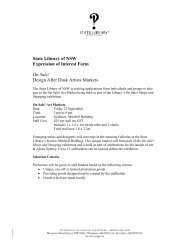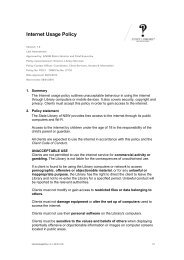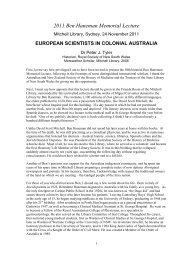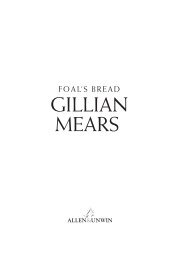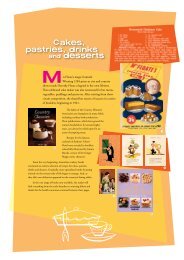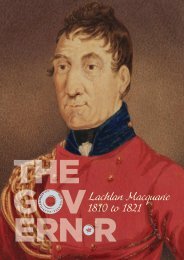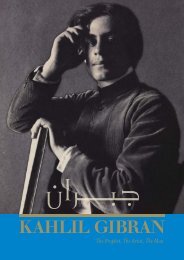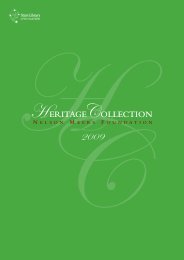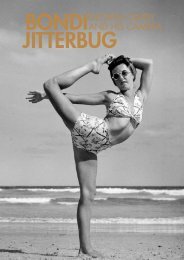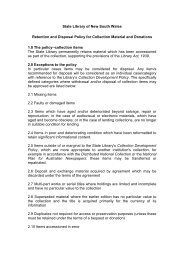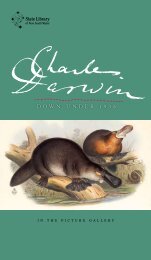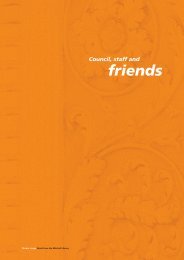SL Magazine December 2008 - State Library of New South Wales
SL Magazine December 2008 - State Library of New South Wales
SL Magazine December 2008 - State Library of New South Wales
- No tags were found...
You also want an ePaper? Increase the reach of your titles
YUMPU automatically turns print PDFs into web optimized ePapers that Google loves.
medieval medicine:not for the faint-heartedDr Carmel Bendon Davisrecently gave anentertaining talk at the<strong>Library</strong> about medievalmedicine, whichoriginated withHippocrates andaristotle, but wascommunicated to theWest through thewritings <strong>of</strong> galen.Here she recounts howeach person had apredominant ‘humour’and the terribleconsequences <strong>of</strong> one’shumour being out <strong>of</strong>balance!Falling ill in the middle ages was arisky business — the treatmentswere frequently more odious thanthe disease. Take, for example, theremedy for jaundice <strong>of</strong>fered by Hildegard<strong>of</strong> Bingen, the 12th century Rhinelandvisionary. She advised sufferers to weara stunned bat (yes, <strong>of</strong> the flying kind)around their neck until the bat expired.To our modern sensibilities thisrecommendation seems useless at best,but it was a treatment entirely consistentwith the medieval understanding <strong>of</strong>human physiology and illness.That understanding originated withHippocrates (460–377BC) and aristotle(384–324BC), but was developed,refined and transmitted to the Westvia the writings <strong>of</strong> galen (129–216aD),whose approach dominated the theoryand practice <strong>of</strong> medicine throughout themiddle ages.galenism regarded the humanbody as a microcosm <strong>of</strong> the vastmacrocosm <strong>of</strong> the known universe,which was believed to be made up <strong>of</strong>four elements: earth, fire, water and air.all things — animate and inanimate —were composed <strong>of</strong> various combinations<strong>of</strong> these elements and <strong>of</strong> their contraries:cold, hot, moist and dry.Particular combinations <strong>of</strong> anytwo <strong>of</strong> the contraries produced ineach and every person one <strong>of</strong> fourmain complexions or temperaments,and an accompanying predominantbodily fluid (humour). For example, thecombination <strong>of</strong> hot and moist contrariesresulted in a sanguine temperamentand a predominance <strong>of</strong> blood inthe system; hot and dry contrariesproduced a choleric temperamentand a predominance <strong>of</strong> yellow bile; acold and dry combination resulted ina melancholic temperament and anaccompanying abundance <strong>of</strong> black bile,while a cold and moist mixture produceda phlegmatic individual, in possession <strong>of</strong>a generous amount <strong>of</strong> phlegm.illness was understood to be adisturbance in a patient’s predominatinghumour, therefore the treatment aimedto restore the humeral balance. anoverabundance <strong>of</strong> blood in the system,Potatus or Potatoes from The Herballor Generall Historie <strong>of</strong> Plantes,John gerarde, 1597, mRB/ Q580/ gfor example, was <strong>of</strong>ten treated by theapplication <strong>of</strong> leeches. Herbs, with theirown particular humeral qualities, werea popular treatment, as was carefulattention to the patient’s diet. Cookedapples, for example, were consideredto be very beneficial for the sick, anda salve made from apple leaves wasgood for the eyes. The tansy herb wasfavoured as a treatment for catarrh,while a brew <strong>of</strong> comfrey, marigold, wildsage and yarrow was recommended toease the pain associated with bruising,following trauma.a physician would diagnose anillness by observing variations inthe colour, odour, appearance andconsistency <strong>of</strong> the patient’s excreta.The pulse was also thoroughly checked,and described according to suchvariables as strength and rhythm.if a patient had sustained an injury, orwas suffering from an ailment that couldnot be treated with herbs, purgativesor dietary adjustments, surgery wassometimes performed. This was perilousindeed given the total ignorance <strong>of</strong>germs. The possibility <strong>of</strong> a fatal infectionfollowing surgery was high.anaesthetics, too, were unknownand medieval patients had to undergoeverything from cataract surgery16magazine



